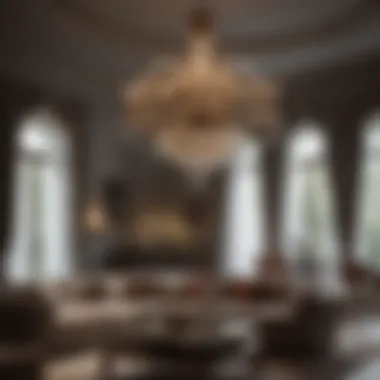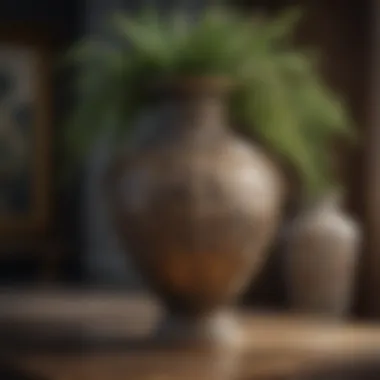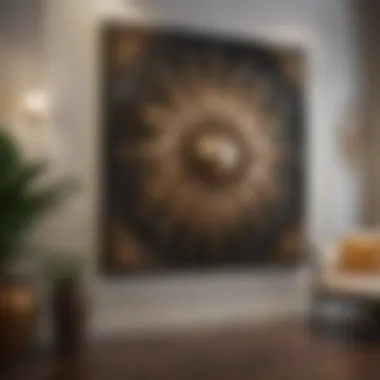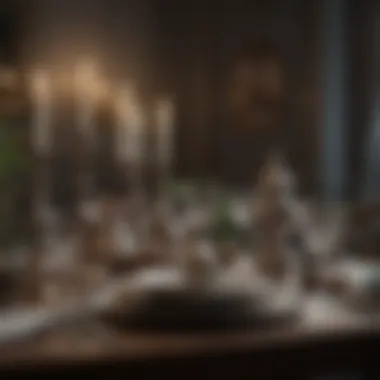The Allure of Luxury Ornaments in Interior Design


Intro
Luxury ornaments in interior design have moved beyond mere decoration; they are now seen as essential elements that enhance the aesthetic quality of a space. Homeowners and design enthusiasts increasingly recognize the importance of these luxurious touches, which can significantly alter the atmosphere of both residential and commercial interiors. This article aims to unpack the intricate relationship between luxury ornaments and interior design by exploring their historical significance, contemporary trends, and practical applications. By understanding these aspects, readers can appreciate how luxury ornaments contribute to creating sophisticated and refined living spaces.
Design Inspiration
Trending Styles and Themes
In the realm of luxury interior design, styles constantly evolve. Current trends showcase a blend of classical and modern elements. Many homeowners are gravitating toward pieces that reflect minimalism while incorporating opulent materials. For example, a sleek marble coffee table paired with velvet chairs can establish a dialogue between simplicity and elegance.
Another notable trend is the use of eclectic themes that draw from various cultural influences. It’s not uncommon to see artisanal items* from distant lands coexisting with contemporary furniture. This interaction not only tells a unique story but also elevates the overall design ethos of the space.
Color Palettes and Combinations
Colors play a pivotal role in accentuating luxury ornaments. Bold jewel tones like emerald green or sapphire blue evoke a sense of richness. Combining these hues with neutral shades creates a balanced visual appeal. Subtle metallic accents, such as gold or silver, can also enrich color palettes, offering layers of depth in the interior.
"The beauty of luxury ornaments lies not just in their materials, but also in how they interact with light and color in their environment."
Furthermore, thoughtful combinations can provide a cohesive look. Selecting a dominant color and several complementary shades ensures that luxury ornaments are harmonized with existing furnishings. This approach helps form a unified theme while allowing individual pieces to shine.
By carefully curating colors and styles, homeowners can create spaces that are not only personal but also inherently stylish. The choice of luxury ornaments becomes vital, as it influences the overall mood of the environment. Through the lens of these insights, one can begin to see how crucial these details are for both function and aesthetics in interior design.
Prolusion to Luxury Ornaments
Luxury ornaments play a vital role in establishing the aesthetic identity of modern interior spaces. These pieces are not merely decorative; they encapsulate the essence of a homeowner's style, values, and aspirations. The unique charm of luxury ornaments often lies in their ability to transform a simple room into a space that tells a story.
Understanding luxury in interior design involves grasping more than just the material worth of objects. It expands into the realm of emotional connection and sensory experience. A thoughtfully curated selection sends a message about personal taste, sophistication, and comfort.
Choosing the right luxury ornaments requires an understanding of various elements, including the materials used, historical influences, and contextual appropriateness within a space. Beyond visual appeal, these ornaments can enhance ambiance, provoke thought, and inspire emotion.
In this article, we will explore the multifaceted dimensions of luxury ornaments. We will delve into their materials, styles, cultural influences, and the current trends that shape their application in design. Each section aims to provide clear insights and considerations for those looking to enrich their interiors.
"Ornamentation in design is where art meets functionality, creating spaces that resonate with both beauty and purpose."
This exploration isn’t just for designers; it offers value to homeowners, interior design enthusiasts, event hosts, and anyone interested in elevating their living spaces. The allure of luxury ornaments lies in their potential to inspire and influence interior design choices, setting the tone for both functionality and aesthetics.
Materials Used in Luxury Ornaments
The significance of materials in luxury ornaments is undeniable. They contribute to the overall aesthetic, feel, and value of the interior space. Each material carries its own unique characteristics and serves different purposes in design. When discussing luxury ornaments, understanding the materials used is crucial for making informed design choices.
Organic Materials: Wood and Stone
Characteristics of Luxury Woods
Luxury woods are often selected for their beauty and durability. They add warmth and richness to a space. Some popular choices include mahogany, walnut, and cherry. Each type has distinct grain patterns and hues that can enhance any interior. The key characteristic of these woods is their ability to age beautifully. This aging process often increases their value over time, making them a long-term investment.
A unique feature of luxury woods is their versatility. They can be crafted into various forms, from furniture to intricate carvings. However, they require proper care to maintain their appearance. Humidity and temperature fluctuations can impact their integrity. Understanding these factors is essential when incorporating wood into luxury designs.
Natural Stones in Design
Natural stones like marble, granite, and limestone bring an element of timeless elegance to interiors. Their natural variations create unique patterns that can serve as focal points in any room. A key characteristic of natural stones is their durability, making them suitable for high-traffic areas. They have a classic appeal and can elevate the overall environment.
Their unique feature lies in how they possess both utility and beauty. For example, marble can be used for flooring, countertops, and even wall cladding. Nonetheless, some natural stones can be porous, requiring sealing to prevent staining. This consideration is vital during the selection process.
Metals and Their Impact


Gold and Silver Accents
Using gold and silver accents in interior design can provide an air of sophistication. These metals can be incorporated through fixtures, mirrors, and decorative elements. The key characteristic of gold and silver is their reflective quality. They enhance light in a room and can make spaces appear larger.
The unique feature of these metals is their adaptability. They can fit into various design styles, from modern to traditional. However, gold and silver accents can be perceived as extravagant if not balanced correctly. It is essential to incorporate them thoughtfully to avoid overwhelming the space.
Brass versus Chrome Finishes
When considering finishes, the debate between brass and chrome is noteworthy. Brass is often associated with warmth and vintage charm, while chrome offers a sleek, modern look. The key characteristic of brass is its weight and sturdiness. In contrast, chrome is lighter and easier to maintain.
Brass has a unique feature in that it develops a patina over time, which can add character. However, this may not be desirable for those seeking a pristine look. Chrome, though easier to clean, can show fingerprints and smudges. Your choice will depend on the desired aesthetic and maintenance preferences.
Textiles and Fabrics in Ornamentation
Silk and Velvet Applications
Silk and velvet are two luxurious fabrics commonly seen in high-end interiors. Silk is known for its sheen and softness, while velvet adds depth and richness. Both fabrics can be used in drapery, upholstery, and decorative pillows. The key characteristic of these materials is their tactile nature, which invites touch and enhances comfort.
The unique feature of silk is its breathability, while velvet offers a luxurious visual texture. Silk can be more delicate, requiring careful cleaning, but it looks stunning in light. Velvet, although more durable, can be prone to crushing and may require occasional maintenance. Understanding these nuances will guide effective selections in ornamentation.
Pattern and Color Considerations
Patterns and colors play a significant role in interior design, especially in luxury settings. Selecting a compelling pattern can provide visual interest and enhance the overall ambiance. A key characteristic of color selection is its effect on mood and perception. Lighter colors can make a space feel larger and more open, while darker shades can create an intimate and cozy atmosphere.
The unique feature of patterns is their ability to convey style, from traditional damasks to modern geometric designs. However, using too many competing patterns can lead to chaos. It is essential to strike a balance that aligns with the desired design ethos. Understanding how to harmonize colors and patterns is vital for achieving a cohesive look.
Styles of Luxury Ornaments
The selection and application of ornamentation styles are crucial in defining the overall aesthetic of an interior space. Luxury ornaments serve not just a decorative purpose but also convey a sense of identity and value to homeowners and design enthusiasts. Understanding different styles helps in making informed choices to elevate the sophistication of living areas. Each style brings unique benefits, considerations, and characteristics that contribute to the overall design narrative.
Classical Ornamentation
Classical ornamentation draws heavily from historical artistic movements, bringing with it a sense of timeless elegance. The intricate details and lavish designs characteristic of this style create immersive environments.
Baroque and Rococo Influences
The Baroque and Rococo styles are notable for their exuberance and dramatic flair. Baroque, with its bold forms and ornate decorations, transforms interiors into dynamic showcases of art. Rococo, on the other hand, favors soft curves and pastel colors, imparting a lighter and more playful touch.
A key characteristic of Baroque designs is the use of grandeur. This style often features gilded surfaces and intricate carvings that command attention. Such opulence is beneficial for those looking to impress guests and create a sense of luxury. However, the overwhelming nature of Baroque can sometimes clash with more minimalist elements.
Rococo brings in a unique feature of asymmetry and elaborate decorations. Its advantage lies in the ability to create inviting and warm atmospheres. Still, its playful nature might not suit all design preferences, especially those leaning towards contemporary aesthetics.
Neoclassical Revival
Neoclassical Revival is a movement that reflects the ideals of symmetry and proportion grounded in classical architecture. This style emphasizes clean lines and classical motifs like columns and pediments. A major advantage of Neoclassical design is its versatility. Safely bridging traditional and modern styles, it appeals to various tastes in home decor.
The unique feature of Neoclassical ornamentation is its balanced composition. This balance creates harmony within a space, making it suitable for countless settings, from grand halls to cozy living rooms. Nonetheless, the reliance on traditional forms may feel outdated to those drawn to modernism.
Modern and Contemporary Designs
Embracing a different philosophy, modern and contemporary designs focus on simplicity and functionality. These styles prioritize stripped-down aesthetics, allowing luxury to shine without excess.
Minimalism and Luxury
Minimalism in luxury design celebrates the beauty of simplicity, showcasing high-quality materials and craftsmanship without clutter. The key characteristic here is restraint, where every piece is carefully chosen to contribute to a harmonious whole. This approach fosters an inviting atmosphere that promotes relaxation.


A unique aspect of minimalist luxury is its emphasis on open spaces. By reducing visual distractions, homeowners can create serene environments. However, the challenge lies in finding the balance—too much minimalism might create a cold or unwelcoming feel.
Mixed Media Approaches
Mixed media approaches integrate various materials and textures, resulting in diverse and personalized environments. This style encourages creativity, where glass, metal, wood, and textiles intertwine to form unique designs. Such a characteristic allows for a high degree of customization, appealing to homeowners who wish to express their individuality.
One advantage of mixed media is its capacity to evoke conversation within a space. Unique pieces can be focal points, drawing visitors' attention. On the downside, poorly executed combinations might lead to visual chaos or inconsistency in design, which is crucial to avoid.
Cultural Influences on Ornamentation
Incorporating cultural elements into ornamentation can enrich a design narrative significantly. Culturally influenced designs convey stories, showcasing heritage and craftsmanship.
Asian Design Elements
Asian design elements are often noted for their balance and harmony. A key characteristic is the use of natural materials and organic lines, fostering a tranquil atmosphere. Their incorporation brings a peaceful and meditative quality to spaces, making it a popular choice for many.
The unique feature of Asian ornamentation is its connection to nature. Elements like bamboo and stone create serene environments. Yet, the challenge lies in maintaining authenticity, as misaligned interpretations can result in stereotypes or inaccuracies.
European Art Movements
European art movements, such as Gothic and Art Nouveau, contribute dramatic flair to interior ornamentation. They celebrate intricate details and often employ bold colors and shapes. A significant advantage of these designs is their ability to create visually striking experiences.
A distinctive feature of European art movements is their historical depth, connecting modern designs with past artistry. However, their complexity may not suit minimalist preferences, potentially clashing with simpler decor styles.
Understanding the various styles of luxury ornaments is essential for creating spaces that reflect personal taste and sophistication.
By contrasting classical, modern, and cultural styles, homeowners can curate spaces that resonate with their values and lifestyle.
Incorporating Luxury Ornaments into Your Space
The integration of luxury ornaments into interior design is a fundamental aspect that enhances the overall aesthetic and emotional appeal of any space. These ornaments do not merely serve decorative purposes; they evoke feelings and establish an ambiance that resonates with personal taste and lifestyle. Incorporating these elements thoughtfully can transform a mundane area into an exquisite haven. The process, however, involves careful consideration of various factors, ensuring that the selected pieces harmonize with the existing decor while also reflecting the style of the homeowner.
Understanding Scale and Proportion
When adding luxury ornaments, understanding scale and proportion is crucial. Choosing items that align properly with the size of the room alters the balance and flow of space. Oversized pieces might overwhelm a small room, while tiny ornaments can get lost in expansive spaces. To create visual appeal, it is essential to measure the dimensions of both the ornament and the space in which it will reside. This will help ensure that these elements interact nicely with one another, enhancing the overall design rather than detracting from it.
Consider a large crystal chandelier in a high-ceilinged living room; it could enhance grandeur. In contrast, a delicate porcelain vase suits a smaller shelf without dominating the area. The key is to strike a balance that feels both intentional and refined.
Color Palette Integration
Color palette integration brings cohesion and unity to a space. Luxury ornaments can introduce rich textures and hues that complement the existing palette of the room. Before selection, consider the dominant colors of the space. For instance, if the room features neutral tones, a luxurious red velvet cushion can serve as a striking accent. Alternatively, metallic finishes like gold or silver can add sophistication and enhance visual interest.
It is also helpful to categorize colors into warm and cool tones. When these tones are mixed, they can create visual harmony. It can also be beneficial to use a color wheel to choose complementary colors that achieve a captivating effect. The aim is not only to beautify but also to facilitate a seamless transition throughout the environment.
Creating Focal Points
The strategic placement of luxury ornaments can assist in creating focal points that guide the eye and attention. A focal point can be anything from an ornate mirror above a fireplace to a striking sculpture in an entryway. Such focal points should not only capture attention but also tell a story about the homeowner's style and preferences.
To create effective focal points, consider the following:
- Height: Use taller items to draw the eye upwards, especially in rooms with high ceilings.
- Contrast: Position light-colored items against darker backgrounds or vice versa to enhance visibility.
- Symmetry: For a balanced look, consider placing matching pieces symmetrically around a central point, such as two identical lamps on either side of a couch.
By focusing on these elements, one can elevate the intricacy and allure of the space. Luxury ornaments, when selected and placed wisely, serve not just as embellishments but as essential components of thoughtful interior design.
Custom versus Off-the-Shelf Luxury Ornaments


The choice between custom and off-the-shelf luxury ornaments is significant in interior design. Each option presents unique advantages and challenges. Understanding these elements is crucial for homeowners and interior design enthusiasts who want to enhance their living spaces effectively.
Custom-designed ornaments allow for a tailored approach that directly reflects personal tastes and design goals. These pieces can be crafted to suit specific dimensions, styles, and functionalities, seamlessly integrating into the unique characteristics of a space. A custom ornament often results in a one-of-a-kind feature that expresses individuality. However, this personalized option may come with a higher cost, extensive lead times, and the need to collaborate closely with designers or artisans.
On the other hand, off-the-shelf luxury ornaments can provide immediate availability and convenience. They allow for a broad range of styles and prices, appealing to various preferences and budgets. This option can be particularly attractive for individuals who need to make quick decisions regarding their interior decor. However, it may lack the distinctive touches that define custom creations, possibly making the space feel less personal.
Both choices lead to an important discussion on how they fit into the overall design vision of a room, whether it be for a home, an event, or even a garden.
Advantages of Custom Designs
Advantages of custom designs go beyond aesthetics; they offer significant functional benefits as well. The following points illustrate why many homeowners opt for custom over standard options:
- Personalization: Custom designs allow for personalization, ensuring that every aspect aligns with the homeowner’s vision.
- Quality Materials: The use of high-quality materials can be a defining feature of custom ornaments, often surpassing off-the-shelf standards.
- Unique Character: Custom designs create a unique character and story within each space, fostering a deeper connection between the occupant and their environment.
- Specific Needs: They cater to specific design needs, such as spacing, texture, or color matching, that off-the-shelf products may not address.
While the investment in custom designs may be substantial, many find the long-term benefits outweigh the initial expense.
Evaluating Off-the-Shelf Options
When considering off-the-shelf luxury ornaments, it is essential to evaluate several factors to ensure satisfactory results. Here are some aspects to consider:
- Quality: Assess the material quality and craftsmanship. Not all off-the-shelf options are created equal.
- Aesthetic Compatibility: Ensure that any selected ornament aligns with the overall aesthetic of the space. This includes evaluating colors, texture, and style.
- Budget-Friendly: Off-the-shelf products are often more budget-friendly. This can be an appealing option for those looking to achieve luxurious results without extensive financial commitments.
- Availability: Evaluate the availability of the products. Unlike custom ornaments, which may have long lead times, off-the-shelf items often offer immediate access.
- Return Policies: Check the return policies of the retailer. Off-the-shelf purchases should be flexible enough to allow for returns or exchanges if they do not suit the desired environment.
Trends in Luxury Ornamentation
Luxury ornamentation in interior design often reflects current social values and technological progress. In recent years, homeowners and designers have focused more on sustainability and ethical practices. This shift emphasizes the importance of making choices that are not only aesthetically pleasing but also environmentally responsible.
Sustainability and Ethical Sourcing
One major trend is the growing emphasis on sustainability and ethical sourcing. Homeowners now seek luxury ornaments that come from responsibly managed sources. This includes choosing materials that are recycled, reclaimed, or sustainably harvested. The demand for transparency in sourcing reflects a broader social awareness towards environmental protection. For instance, materials like reclaimed wood or ethically sourced stone are becoming increasingly popular. These choices not only reduce the impact on the environment but also add a unique story to each piece.
The benefits of bringing sustainability into luxury ornamentation are manifold:
- Reduced Environmental Impact: By selecting materials that are sourced ethically, individuals often minimize the carbon footprint of their interiors.
- Unique Character: Sustainable materials often carry unique textures or histories, which can create a more distinctive aesthetic.
- Consumer Loyalty: Many consumers are willing to pay a premium for products that align with their ethical values.
Technological Integration
Another significant trend is the integration of technology into luxury ornamentation. Smart home technologies are shaping how we think about light fixtures, art pieces, and even furniture. There is an increase in demand for ornaments that incorporate smart features. This can mean anything from smart mirrors that can display information to artwork that changes based on mood lighting.
Technological advances can enhance the functionality of luxury ornaments:
- Smart Lighting: Incorporating LED technology allows for customizable settings that can change the ambiance of a room.
- Interactive Art: Digital art displays change images based on viewer interaction, providing a unique experience in every visit.
- Automated Features: Some furniture and decor automatically adjust to enhance comfort and usability effectively.
The End: The Role of Luxury Ornaments
Luxury ornaments play a crucial part in shaping the identity of modern interiors. Their impact extends beyond simple aesthetics; they can enhance the emotional resonance of a space and elevate the everyday experiences of those who inhabit it. In this article, we explored how luxury ornamentation intertwines with design principles, emphasizing the intricate ways it contributes to a refined atmosphere.
Final Thoughts on Design Choices
When selecting luxury ornaments, it is vital to consider not just the visual impact but also how they reflect personal taste and lifestyle. The harmony between luxury pieces and the overall design theme of a space ensures a cohesive aesthetic. Key aspects to keep in mind include:
- Scale: Ensure that the size of the ornaments complements the space. Oversized pieces may overwhelm smaller rooms, while petite items might get lost in larger spaces.
- Color Palette: Choosing ornaments that resonate with the existing color scheme creates unity. Neutral tones can bring sophistication, while bold colors can add vibrancy.
- Material: The choice of material significantly affects the ambiance. For example, the warmth of natural wood contrasts with the coldness of metal, creating different feelings within a space.
All these elements play an essential role in making informed design choices that emphasize the true value of luxury ornaments.
Looking Ahead in Ornamentation
The realm of luxury ornamentation continues to evolve, with several trends gaining momentum. Consumers are increasingly drawn to sustainable options, favoring ethical sourcing and eco-friendly materials. This shift not only supports environmental stewardship but also enhances the narrative value of the ornaments themselves.
Technological advancements also reshape how ornaments are crafted and experienced. From 3D printing to smart materials, these innovations offer new possibilities for customization and functionality.
In summary, the future of luxury ornamentation will be defined by a synergy of tradition and innovation, where craftsmanship meets modern needs.



